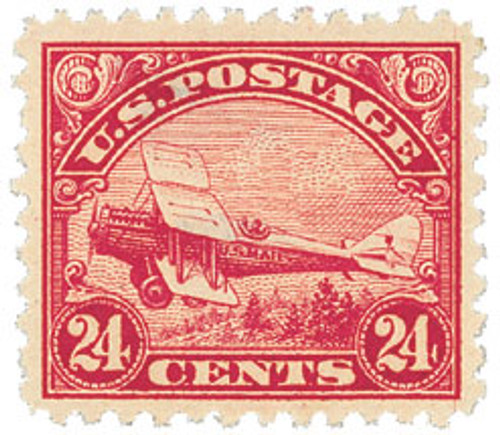U.S. #573a
Series of 1922-25 $5 America
Flat Plate Printing
Issue Date: March 20, 1923
First City: Washington, DC
Quantity Issued: 1,652,167
Printed by: Bureau of Engraving and Printing
Printing Method: Flat plate
Perforation: 11 gauge
Color: Carmine lake and dark blue
U.S. #573 was first issued on March 20, 1923. Only 1.65 million #573 stamps were produced – far less than the quantity for other stamps from this series. In addition to the low quantity, five dollars was a great deal of money in 1923. When adjusted for inflation, $5 in 1923 would be worth over $200 in wages today. Many stamp collectors were unable to invest in such an expensive stamp.
New 1922 Series Subject of Widespread Newspaper Publicity
In 1922, the Post Office Department announced it was considering a new series of stamps to replace the then-current Washington-Franklin stamps, which had been in use with relatively few changes since 1908. Naturally the news resulted in widespread newspaper publicity. Some criticized the change, stating the new stamps were only being produced to satisfy collectors. Postmaster General W. Irving Glover denied the statements and attributed the change to complaints about the striking similarity of the Washington-Franklin stamps.
Only Bi-Color Stamp of the New Series
The $5 America stamp was part of the new series. In addition to creating distinctly different stamps, the Post Office also worked to produce stamps that were interesting and attractive. The new stamps featured prominent Americans, along with scenes of national interest. The high-value $5 stamp pictures the “Statue of Freedom,” also known as “Armed Freedom,” which graces the dome of the U.S. Capitol Building. The stamp was printed in patriotic carmine and blue, making it the only bi-color stamp of the Series of 1922-25. (Bi-color production involves printing the frame and central design in two separate steps. The process made precise alignment of the two elements difficult – so U.S. #573 stamps with fine centering are especially prized.)
A Symbol of Unity and Strength
The Capitol dome and the “Statue of Freedom” have an interesting history. Construction of the dome was incomplete when the Civil War began in 1861. Although resources on both sides of the conflict were strained, President Abraham Lincoln insisted the work continue as a symbol of American unity. Nearly 9 million pounds of ironwork was used to build the famous Capitol dome. On December 2, 1863, the “Statue of Freedom” was placed on top of the dome. Fanfare included a 35-gun salute – one for every state of the divided Union – and a return salute from 12 forts surrounding Washington, D.C. The pageantry, and the “Statue of Freedom,” were visible from nearby Virginia – the seat of the Confederate States of America!
Powerfully symbolic, the “Statue of Freedom” had graced the Newspaper and Periodical Revenue stamps of 1875 and 1895. When the figure was again selected for the new stamp series in 1922, the Bureau of Engraving and Printing referred to an existing engraving in its files. However, the engraving was mistakenly labeled “America,” and the incorrect name was inscribed on the $5 stamp.


















